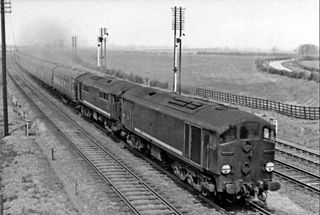British Rail Class 28
Metropolitan Vickers Type 2,
British Rail Class 28

|
|
|
|
|
| Performance figures |
| Maximum speed |
75 mph (121 km/h) |
| Power output |
Engine: 1,200 hp (895 kW) |
| Tractive effort |
Maximum: 50,000 lbf (222 kN) |
|
| Career |
| Operators |
British Railways |
| Numbers |
D5700–D5719 |
| Axle load class |
Route availability 6 |
| Retired |
December 1967 – September 1969 |
| Disposition |
One preserved, remainder scrapped |
|
| Performance figures |
| Maximum speed |
75 mph (121 km/h) |
| Power output |
Engine: 1,200 hp (895 kW) |
| Tractive effort |
Maximum: 50,000 lbf (222 kN) |
| Career |
| Operators |
British Railways |
| Numbers |
D5700–D5719 |
| Axle load class |
Route availability 6 |
| Retired |
December 1967 – September 1969 |
| Disposition |
One preserved, remainder scrapped |
The British Rail Class 28 (Metropolitan-Vickers Type 2) diesel locomotives, or 'Metrovicks' as they were popularly known, were built as part of the British Railways 1955 Modernisation Plan. The locomotives had a Co-Bo wheel arrangement (a 6-wheel bogie at one end, a 4-wheel bogie at the other) – unique in British Railways practice and uncommon in other countries, although Japan also used some C-B diesel hydraulics. This made maintenance more complicated. The maximum tractive effort of 50,000 lbf (220 kN) was unusually high for a Type 2 locomotive but, as there were five (not four) driving axles, the risk of wheelslip was minimal.
With low-speed Crossley 8-cylinder HST Vee8 two stroke engines, they represented an experiment in two stroke versus four stroke engines for diesel-electric traction.
The engines had exhaust pulse pressure charging and developed 1,200 horsepower (895 kW) at 625 rpm. There were no valves, and inlet and exhaust were via ports in the cylinder walls. The same engine was originally fitted in the Irish A Class and the Western Australian Government Railways X class. A similar, but smaller engine, the ESNT6 was used in the D3/3 shunters, an 08 with a Crossley engine rather than English-Electric.
...
Wikipedia

